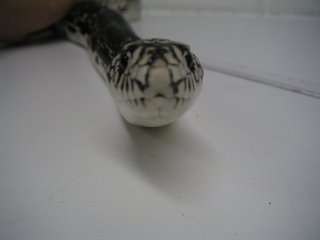Animal Encounters III
This week, I'm glad to have:
The Northern Pine Snake

Cassidy
There are four types of pine snakes that can be found in the United States. The northern pine snake is found in the Northern and Eastern-Central regions of the country, in areas with sandy soils and dry upland forests. The population distribution of this pine snake is spotty and all indications suggest that pine snake abundance is decreasing throughout the Northeastern region. As a result, all states in which they are found have listed them as either endangered or threatened. The northern pine snake is known for being secretive and is therefore challenging to study and detect. This species of snake, which rarely climbs vegetation and prefers to be on the ground, has the ability to tunnel underground and excavate its own nests, summer dens and places to hibernate. Therefore, scientists believe that it prefers the more pliable sandy soils and forested areas of the Pinelands.

Argh! Too fast!
The northern pine snake can grow to 5 feet to 7 feet long and has a black and dull white pattern. They can live up to 21 years in captivity. There are dark blotches along the top and sides of the body which are less distinct in the front part of the body and more distinct in the hind part. The belly is white with rows of black dots along either side.

My shielded nose!
This species of snake has a small pointed head with a tipped snout and thick neck, which are helpful when it moves soil around or burrows. It also has a special scale at the front of its snout that shields its nose and protects it as it tunnels underground. In fact, much of its time is spent hidden underground.

Check out my black tongue!
The pine snake is a nonvenomous constrictor. It kills its prey by coiling itself around it in order to suffocate the animal. Pine snakes are known to eat mammals as large as rabbits, as well as small rodents and birds. They are usually most active in early morning or late afternoon when they leave their burrows to hunt. Pine snakes are egg-layers and typically lay their eggs in underground nests that they excavate in open sandy areas. Eggs are usually laid in mid-summer, and adult females have the tendency to re-use their nest sites year after year.

Never do this at home
Photographing a snake is one of the hardest things I've ever done, especially when you've got a shitty camera like mine. Its also pretty dangerous. Thank god Cassidy is nonvenmomous. Its a she, and today, she was very active (must be her feeding day). We've got two Northern Pine snakes in our section, Cassidy and Fluffy. Cassidy is the bigger of the two. She's about 1.5m long, and she's very fast and very muscular. She was getting very moody towards the end and was making hissing noises at the camera.

Er....time to go
So thats probably it for now. Perhaps next week, if the weather's good, I might be able to get a special guest!


0 Comments:
Post a Comment
<< Home